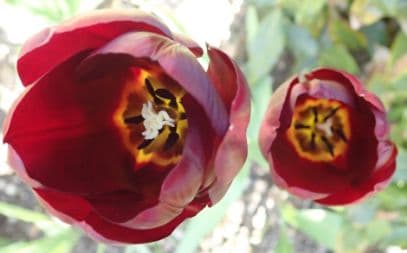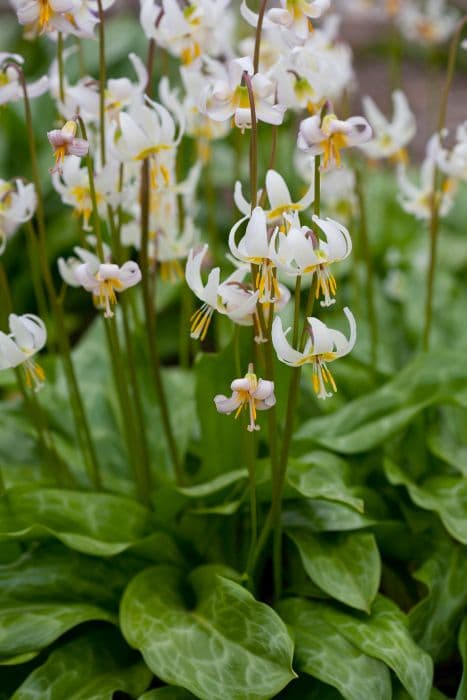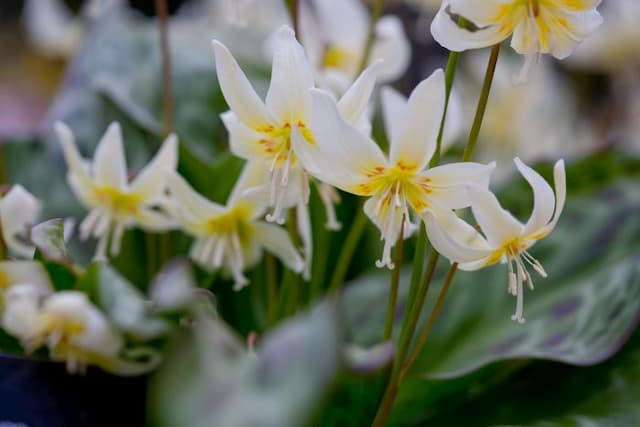Tulip Tulipa 'Jan Reus' (3)

ABOUT
The Tulipa 'Jan Reus' (3), also known as the tulip 'Jan Reus', is a striking flowering plant known for its beautiful blooms. The flowers of this tulip variety have a classic cup-shaped form that is characteristic of many tulips, with a bold and dramatic appearance. The petals are rich crimson in color, creating an eye-catching display that can add a splash of deep red to any garden. These petals may exhibit a hint of silky sheen which can reflect sunlight, giving them a luminous quality. The leaves of the tulip 'Jan Reus' are typically a lush green color, providing a sturdy backdrop that contrasts with and enhances the visual impact of the brilliant flowers. These leaves are elongated with a smooth and somewhat waxy surface, arching gently from the base of the plant. Overall, the tulip 'Jan Reus' is distinguished by its color and classic tulip shape. Its vibrant red blossoms are commonly associated with strong visual statements in garden design and are often planted in groups for a more dramatic effect. The plant blooms in the spring, offering a seasonal spectacle that heralds the end of winter and the onset of warmer weather.
About this plant
 Names
NamesFamily
Liliaceae
Synonyms
Jan Reus Tulip, Triumph Tulip
Common names
Tulipa 'Jan Reus'.
 Toxicity
ToxicityTo humans
The Tulip, including the 'Jan Reus' variety, can be toxic to humans if ingested. Eating any part of the tulip can cause symptoms like nausea, vomiting, and diarrhea. In addition, the bulb is the most toxic part and can also cause dizziness and abdominal pain if consumed. Handling the bulbs may cause allergic reactions or dermatitis in sensitive individuals.
To pets
The Tulip, including the 'Jan Reus' cultivar, is toxic to pets, such as cats and dogs. Ingestion can lead to symptoms including vomiting, drooling, or diarrhea. The most toxic part of the plant is the bulb, which can also cause depression of the central nervous system, an increase in heart rate, and difficulty breathing if consumed in larger quantities. It's important to prevent pets from accessing tulips to avoid these potential health issues.
 Characteristics
CharacteristicsLife cycle
Perennials
Foliage type
Deciduous
Color of leaves
Green
Flower color
Red
Height
1 foot 6 inches (45-60 cm)
Spread
6 inches (15 cm)
Plant type
Bulb
Hardiness zones
3
Native area
Central Asia
Benefits
 General Benefits
General Benefits- Spring Color: The Tulipa 'Jan Reus', commonly known as the Tulip, blooms in spring, adding vibrant color to gardens after the winter season.
- Landscape Design: Tulips offer a range of colors and shapes, allowing gardeners to create diverse and attractive landscape designs.
- Cut Flowers: Tulips are popular for cutting and arranging in bouquets, providing beauty indoors and making them valuable for the floral industry.
- Ease of Growing: Tulips are easy to grow in well-drained soil and full sun to partial shade, making them accessible to gardeners of all skill levels.
- Pollinator Attractants: While they are not known for their ability to attract a wide variety of pollinators, tulips can still attract bees and other pollinators during their bloom time.
- Seasonal Interest: Tulips signal the change of seasons, with their bloom indicating the start of spring and warmer weather ahead.
- Bulb Perennialization: Some tulip varieties, including Tulipa 'Jan Reus', can perennialize and come back for several years when given optimal growing conditions.
 Medical Properties
Medical PropertiesThis plant is not used for medical purposes.
 Air-purifying Qualities
Air-purifying QualitiesThis plant is not specifically known for air purifying qualities.
 Other Uses
Other Uses- The bulb of the tulip can be used as a replacement for onions in cooking during times of scarcity, although this is not a common practice due to the possibility of toxic effects.
- Tulip petals are sometimes used as a natural dye for fabrics, giving a range of colors from yellow to green depending on the mordant used.
- The bloom of the tulip can be hollowed out and used as a biodegradable holder for small appetizers or desserts at eco-friendly events.
- Dried tulip petals can be incorporated into potpourri mixtures, contributing a subtle scent and a burst of color.
- Tulip petals are edible and can be used in salads for aesthetic appeal, though they have a very mild flavor.
- Crushed tulip petals can be mixed into paints to add texture and a slight tint to artwork.
- In some cultures, tulip flowers are used in crafting traditional headwear or accessories for festive occasions.
- The sturdy stems of tulips can be used in floral crafts, such as making natural wreaths or as support in decorative arrangements.
- Children can use tulip petals for educational nature crafts, like pressing into clay to create patterns and imprints.
- The tulip's shape and vibrant colors make it ideal for use in photographic projects, teaching principles of composition, and color theory.
Interesting Facts
 Feng Shui
Feng ShuiThe Tulip is not used in Feng Shui practice.
 Zodiac Sign Compitability
Zodiac Sign CompitabilityThe Tulip is not used in astrology practice.
 Plant Symbolism
Plant Symbolism- Perfect Love: Tulips, in general, are often associated with a declaration of perfect love. The robust and bold appearance of 'Jan Reus' Tulips can intensify this representation, making them a fitting choice for romantic gestures.
- Rebirth and Renewal: As heralds of spring, tulips symbolize new beginnings and the renewal that comes with the season. Since 'Jan Reus' tulips bloom in spring, they are associated with this sense of rejuvenation.
- Royalty: The radiant and richly colored 'Jan Reus' has a regal presence that might be linked to nobility and a royal bearing, reflecting its standout nature in the garden.
- Forgiveness: Offering a tulip, including the 'Jan Reus' variety, can be a gesture of asking for forgiveness, as tulips can symbolize an apology and the hope of reconciliation.
- Prosperity: Historically linked to the period of Tulip Mania in the Netherlands, where they had great value, tulips like 'Jan Reus' can also signify abundance and prosperity.
 Water
WaterTulips require moderate watering. For Tulipa 'Jan Reus', you should water when the top inch of soil feels dry, which typically means about once a week during the growing season. It's best to use a soaker hose or drip irrigation to keep moisture at the root level without wetting the foliage, as this can help prevent fungal diseases. Each watering session should provide between half a gallon to a gallon of water, depending on the size of your planting area and the weather conditions. During the dormant period, after the leaves yellow and die back, watering should be reduced significantly.
 Light
LightTulips thrive best in full sunlight. For Tulipa 'Jan Reus', a spot that provides at least six hours of direct sunlight each day is ideal. Avoid locations that are shaded for long periods, as inadequate light can lead to weak stems and poor flowering. If you're planting in a hot climate, some afternoon shade can prevent overheating, but generally, the more light these flowers receive, the better.
 Temperature
TemperatureTulips prefer a temperate climate with cold winters and mild springs. For Tulipa 'Jan Reus', the ideal growing temperature is between 60°F and 70°F during the day and slightly cooler at night. Tulips need a period of cold dormancy; they can tolerate winter temperatures well below freezing and should be planted in the fall, several weeks before the ground freezes. A prolonged period of 35°F to 55°F is necessary for proper root development and to trigger spring blooming.
 Pruning
PruningPruning is not commonly required for tulips, and Tulipa 'Jan Reus' is no exception. Deadhead the flowers after they have bloomed to prevent seed formation, which can divert energy away from the bulb. The foliage should be left intact until it has yellowed and died back naturally; this period allows the plant to photosynthesize and gather nutrients for the next growing season. The best time to remove spent foliage is when it comes away with little to no resistance.
 Cleaning
CleaningAs needed
 Soil
SoilTulip 'Jan Reus' thrives best in a well-draining soil mix with a pH of 6.0 to 7.0. Incorporate compost or aged manure to enrich the soil and ensure it remains fertile. Sand or perlite can be added to improve drainage.
 Repotting
RepottingTulips, including 'Jan Reus', typically do not require repotting as they are perennial bulbs planted outdoors. Instead, they should be lifted and separated every 3-5 years to prevent overcrowding and to maintain vigor.
 Humidity & Misting
Humidity & MistingTulip 'Jan Reus' tolerates a wide range of humidity levels and does not require any specific humidity conditions, as it is generally grown outdoors where the ambient humidity is sufficient.
 Suitable locations
Suitable locationsIndoor
Place in bright light, cool place, water sparingly.
Outdoor
Plant in fall, full sun, well-drained soil.
Hardiness zone
3-8 USDA
 Life cycle
Life cycleThe life of the Tulip 'Jan Reus', commonly known as the Triumph Tulip, begins with the planting of a bulb in fall, several weeks before the ground freezes. During winter, the bulb lies dormant underground, but the cool temperatures are crucial in preparing it for spring growth. Come early spring, the bulb wakes up and sprouts, sending up leaves and a stem as temperatures rise. Through mid to late spring, it blooms, producing the characteristic cup-shaped, red flowers that make Triumph Tulips famous. After flowering, energy is directed back into the bulb as the leaves photosynthesize before the foliage eventually dies back in summer. The cycle repeats itself annually as the bulb lies dormant through another summer and prepares for the next growing season.
 Propogation
PropogationPropogation time
Spring
Tulipa 'Jan Reus', commonly known as the Tulip 'Jan Reus', is typically propagated through the division of its bulbs. The best time to propagate tulips is in the fall, as the bulbs require a period of cold dormancy to bloom successfully in the spring. When the foliage has died back usually in late summer, carefully lift the bulbs from the soil, being mindful not to damage them. Gently separate the smaller, offset bulbs that have formed around the base of the mother bulb. These offsets are your new plants. Replant the bulbs immediately or store them in a cool, dry place until planting time, ensuring each bulb is placed pointy-side up about 6 to 8 inches (approximately 15 to 20 centimeters) apart and at a depth of 6 inches (about 15 centimeters). Water them well after planting to help establish the roots before the winter sets in.









